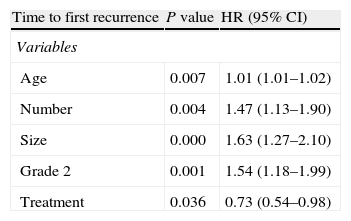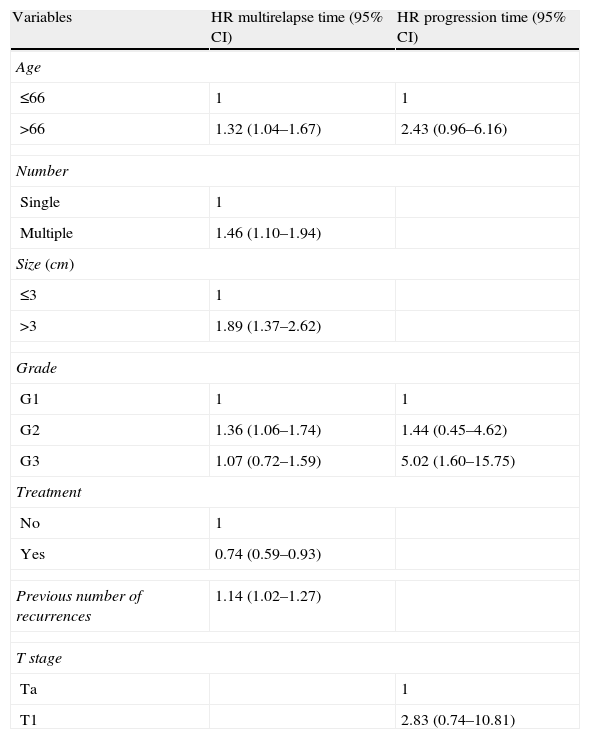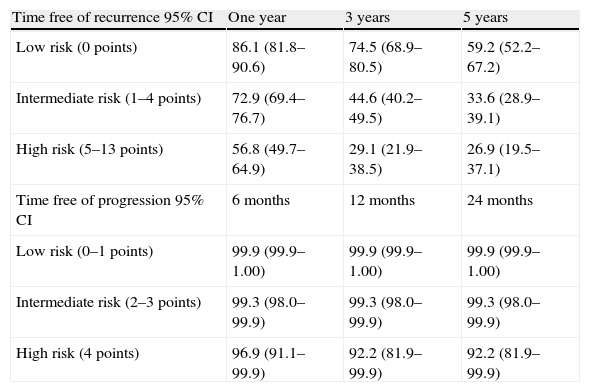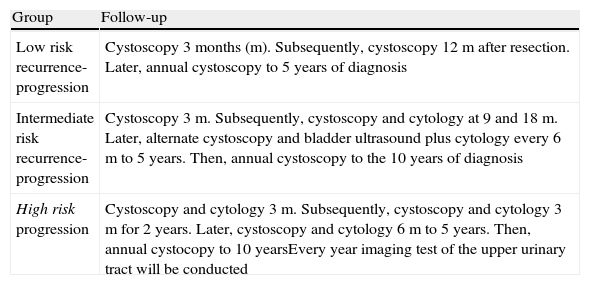To apply new mathematical models according to Non-Muscle Invasive Bladder Carcinoma (NMIBC) biological characteristics and enabling an accurate risk estimation of multiple recurrences and tumor progression. The classical Cox model is not valid for the assessment of this kind of events because the time between recurrences in the same patient may be strongly correlated. These new models for risk estimation of recurrence/progression lead to individualized monitoring and treatment plan.
Materials and methods960 patients with primary NMIBC were enrolled. The median follow-up was 48.1 (3–160) months. Results obtained were validated in 240 patients from other center. Transurethral resection of the bladder (TURB) and random bladder biopsy were performed. Subsequently, adjuvant localized chemotherapy was performed. The variables analyzed were: number and tumor size, age, chemotherapy and histopathology. The endpoints were time to recurrence and time to progression. Cox model and its extensions were used as joint frailty model for multiple recurrence and progression. Model accuracy was calculated using Harrell's concordance index (c-index).
Results468 (48.8%) patients developed at least one tumor recurrence and tumor progression was reported in 52 (5.4%) patients. Variables for multiple-recurrence risk are: age, grade, number, size, treatment and the number of prior recurrences. All these together with age, stage and grade are the variables for progression risk. Concordance index was 0.64 and 0.85 for multiple recurrence and progression respectively.
ConclusionThe high concordance reported besides to the validation process in external source allows accurate multi-recurrence/progression risk estimation. As a consequence, it is possible to schedule a follow-up and treatment individualized plan in new and recurrent NMCB cases.
El carcinoma urotelial de vejiga no músculo-invasivo (CVNMI) se caracteriza por eventos repetidos en forma de recidiva tumoral o la aparición de progresión tumoral. La aplicación del modelo de Cox para analizar estos eventos no es válido, ya que los tiempos entre recurrencias de un mismo paciente pueden estar fuertemente correlacionados, y se requiere otro tipo de modelización matemática. El objetivo del estudio es aplicar nuevos modelos matemáticos apropiados a las características biológicas del CVNMI.
Material y métodosNovecientos sesenta pacientes con diagnóstico de CVNMI con una media de seguimiento de 48,1 (3-160) meses y validación del modelo con 240 pacientes de otro centro. Se realizó resección transuretral con biopsias aleatorias. Las variables analizadas fueron: número y tamaño tumoral, edad, tratamiento adyuvante y características anatomopatológicas del tumor (grado y estadio). Para el análisis estadístico se utilizaron extensiones del modelo de Cox como el modelo de fragilidad conjunta para la multirrecidiva y progresión tumoral. Para la validación del modelo se utilizó el índice de concordancia.
ResultadosCuatrocientos sesenta y ocho (48,8%) pacientes tuvieron una recidiva tumoral y 52 (5,4%) presentaron progresión tumoral. Las variables que formaron parte del modelo para múltiple recidiva fueron la edad, el grado, el número, el tratamiento empleado y el número previo de recidivas, mientras que para progresión fueron la edad, el estadio y el grado. El índice de concordancia fue 0,64 para la multirrecidiva y 0,85 para la progresión.
ConclusiónLa alta concordancia obtenida y la validación con una fuente externa permite predecir con mayor precisión el riesgo de multirrecidiva y progresión.












